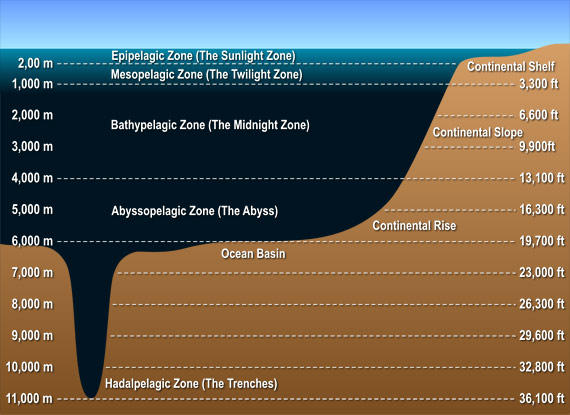Ocean Life
Key Questions
-
Answer:
Generally speaking, coastal areas are very rich in marine life. In the open ocean, most life is found in the epipelagic zone.
Explanation:
Areas just off of the coast, from the shoreline to the edge of the continental shelf tend to have the most marine life. This area is called the neritic zone. It extends from the intertidal zone to the edge of the continental shelf where the oceanic zone begins.
 )
) Of the open ocean zones, most life is found in the epipelagic zone. This is where light is able to penetrate the ocean, allowing for photosynthetic processes to take place. It extends roughly 200m or 650 feet below the surface. This zone may also be known as the euphoric zone, the sunlight zone, or the photic zone.
 )
) It's important to keep in mind though that we have not explored much of the ocean, and the deeper you go the harder it becomes to study the different lifeforms.
To learn more about ocean zones and ocean life, you may want to navigate around the Smithsonian's webpages here.
-
Answer:
The epipelagic zone, mesopelagic zone, bathypelagic zone, abyssopelagic zone, and the hadalpelagic zone are the major marine life zones in the ocean.
Explanation:
The epipelagic zone, mesopelagic zone, bathypelagic zone, abyssopelagic zone, and the hadalpelagic zone are the major marine life zones. Each zone is characterized by depth, with the hadalpelagic zone being the deepest.

Epipelagic -Sunlight reaches this zone. Photosynthesis is possible, hence marine plant life is found at this depth as is most of the life in the ocean.
Mesopelagic - Some light reaches this zone but not enough for photosynthesis to occur. Many of the animals found in this zone have special adaptations for living in low light, such as the lantern fish.
Bathypelagic -No light reaches this depth. Giant squid and angler fish are found at this depth, and whales may dive this deep for prey.
Abyssopelagic -Even fewer animals live in this zone. By this depth, the temperature is close to freezing and the pressure is immense. Many animals are bioluminescent.
Hadalpelagic -Deep sea trenches are in the hadalpelagic zone. Animals may survive of the remains of other organisms which have fallen to the ocean floor. Some survive near hydrothermal vents.